Towards Adaptive Water Management—Optimizing River Water Diversion at the Basin Scale under Future Environmental Conditions
Abstract
:1. Introduction
2. Materials and Methods
2.1. The Pas River Basin
2.2. Problem Perception and Problem Formulation Phase for the Pas River Basin
2.2.1. Problem Perception: Objectives and Optimization Goals
2.2.2. Problem Formulation
Scale and Scenario Setting
- -
- The LU and LC scenarios were developed using the process-based model framework FORE-SCE Model (Forecasting scenario for land change modeling) [47,48]. The FORE-SCE Model simulated current land use and cover by processing elevation, slope, and orientation and modeled fire recurrence. Furthermore, it models the influence of socioeconomic drivers obtained from interviews with local stakeholders and experts in agricultural and urban development policy fields. The input LU and LC maps were derived from historical remote sensing data (Landsat/Sentinel-2 imageries) for the 1990s, 2000s, and 2018 at a spatial resolution of 10 m.
- -
- For climate projections, historical data (from 1950 to 2018) and future data (from 2041 to 2070) on temperature and precipitation were used. See the procedure described in [49].
- -
- The final accumulated river surface runoff data (i.e., the resulting flow in the river) were produced by applying the distributed hydrological model SPHY (Spatial Processes in Hydrology; [50]) at a spatial resolution of 100 m and at the daily time step. Historical precipitation and temperature data for the period 1950 to 2018 were retrieved from the E-OBS v20e database [51] and resampled to produce a spatial resolution of ~1 km. [49] performed a statistical downscaling of precipitation and temperature with Ordinary Least Squares with yearly daily means using latitude, elevation, and Euclidean distance to the coastline as explanatory variables. For future scenarios, climatic datasets from a five-member ensemble of GCM-RCM chain simulations were retrieved for the development of climate change projections for the Pas catchment [49]. Further details of the procedure to develop climatic historical and future series can be found in [49]. Details of the model parameterization are provided in Table S1 in the Supplementary Materials. As shown in Table S2 in the Supplementary Materials, the results of the SPHY simulation (which are used by the optimization model) are characterized by a decline in precipitation and an increase in temperature and water demand due to land use changes. This, in turn, leads to a rise in actual evapotranspiration, causing a decrease in average instream flow in the Pas River basin, with a mean flow reduction rate of 25% between the basin outlets in the 1980–2012 and the 2041–2070 periods.
| Timeframe of Source Data | Considered Period for Modeling | Scenario Name | Description | |
|---|---|---|---|---|
| Historical | 1980–2012 |
| Present day (PR) | This scenario represents present-day land cover and present-day climate. It is used as a comparison to the historical conditions. |
| Future | 2041–2070 |
| BAU future (CC_BAU) | This scenario assumes river discharge is affected by Business as Usual (BAU) future land cover and future climate (RCP 8.5; [49]. It considers the evolution of present-day land use and land cover conditions. In particular, forest patches (monoculture planted forest) development is implemented but not prioritized with the presence of shrubs and rushes. In the upper basin, there is a significant rural abandonment with forest recovery from pastureland, whereas the lower basin is characterized by urban area expansion and agricultural intensification. |
| Nature-based solutions prioritization (CC_BGIN) | This scenario assumes an investment in nature-based solutions and an RCP 8.5 climate change intensity conditions [49]. Concerning the “future conditions” scenario, we have a modification of the rules for land use-land cover evolution (e.g., no fires and forest transitions are favored in places where it can have the highest impact on regulatory ES). This results in a prevalence of hill-side forests (e.g., oak, beech, chestnut, birch species) and riparian forests (e.g., willows, ash, alders). | |||
Environmental Indicators—Definition of Relevant Ecosystem Services for the Pas River
Solution Approach to the Optimization Problem
3. Results
3.1. Performance of the Optimization Objectives
3.2. Spatial and Temporal Distribution of Water Available for Diversion in the Pas River Basin
3.3. Comparison of Results within the Different Scenarios
4. Discussion
4.1. Spatial and Temporal Scale Considerations of Water Available for Diversion
4.2. Supporting Ecosystem Services Objectives across Scenarios
4.3. Optimization Set-Up and Scenarios for Water Diversion Management at Different Scales
4.4. Considerations on Optimization Indicators for Ecological Endpoints
5. Recommendations
6. Conclusions
Supplementary Materials
Author Contributions
Funding
Data Availability Statement
Acknowledgments
Conflicts of Interest
References
- Poff, N.; Allan, J.D.; Bain, M.; Karr, J.; Prestegaard, K.; Richter, B.; Sparks, R.; Stromberg, J. The Natural Flow Regime: A Paradigm for River Conservation and Restoration. Bioscience 1997, 47, 769–784. [Google Scholar] [CrossRef]
- Alamanos, A.; Koundouri, P. Emerging Challenges and the Future of Water Resources Management. HydroLink 2023, 4, 116–120. [Google Scholar]
- Grison, C.; Koop, S.; Eisenreich, S.; Hofman, J.; Chang, I.-S.; Wu, J.; Savic, D.; van Leeuwen, K. Integrated Water Resources Management in Cities in the World: Global Challenges. Water Resour. Manag. 2023, 37, 2787–2803. [Google Scholar] [CrossRef]
- Moghim, S.; Teuling, A.J.; Uijlenhoet, R. A Probabilistic Climate Change Assessment for Europe. Int. J. Climatol. 2022, 42, 6699–6715. [Google Scholar] [CrossRef]
- Ziolkowska, J.R.; Ziolkowski, B. Effectiveness of Water Management in Europe in the 21st Century. Water Resour. Manag. 2016, 30, 2261–2274. [Google Scholar] [CrossRef]
- Stewardson, M.J.; Acreman, M.; Costelloe, J.F.; Fletcher, T.D.; Fowler, K.J.A.; Horne, A.C.; Liu, G.; McClain, M.E.; Peel, M.C. Understanding Hydrological Alteration. In Water for the Environment: From Policy and Science to Implementation and Management; Elsevier Inc.: Amsterdam, The Netherlands, 2017; pp. 37–64. ISBN 9780128039458. [Google Scholar]
- Rolls, R.J.; Bond, N.R. Environmental and Ecological Effects of Flow Alteration in Surface Water Ecosystems. In Water for the Environment: From Policy and Science to Implementation and Management; Elsevier Inc.: Amsterdam, The Netherlands, 2017; pp. 65–82. ISBN 9780128039458. [Google Scholar]
- Watz, J.; Aldvén, D.; Andreasson, P.; Aziz, K.; Blixt, M.; Calles, O.; Lund Bjørnås, K.; Olsson, I.; Österling, M.; Stålhammar, S.; et al. Atlantic Salmon in Regulated Rivers: Understanding River Management through the Ecosystem Services Lens. Fish Fish. 2022, 23, 478–491. [Google Scholar] [CrossRef]
- Alan Yeakley, J.; Ervin, D.; Chang, H.; Granek, E.F.; Dujon, V.; Shandas, V.; Brown, D. Ecosystem Services of Streams and Rivers. In River Science; John Wiley & Sons, Ltd.: Chichester, UK, 2016; pp. 335–352. [Google Scholar]
- Gilvear, D.J.; Beevers, L.C.; O’Keeffe, J.; Acreman, M. Environmental Water Regimes and Natural Capital. In Water for the Environment; Horne, A.C., Webb, J.A., Stewardson, M.J., Richter, B., Acreman, M., Eds.; Elsevier: Amsterdam, The Netherlands, 2017; pp. 151–171. [Google Scholar]
- Jähnig, S.C.; Carolli, M.; Dehnhardt, A.; Jardine, T.; Podschun, S.; Pusch, M.; Scholz, M.; Tharme, R.E.; Wantzen, K.M.; Langhans, S.D. Ecosystem Services of River Systems—Irreplaceable, Undervalued, and at Risk. In Encyclopedia of Inland Waters; Elsevier: Amsterdam, The Netherlands, 2022; pp. 424–435. [Google Scholar]
- Rosero-López, D.; Knighton, J.; Lloret, P.; Encalada, A.C. Invertebrate Response to Impacts of Water Diversion and Flow Regulation in High-altitude Tropical Streams. River Res. Appl. 2020, 36, 223–233. [Google Scholar] [CrossRef]
- Ferreira, V.; Albariño, R.; Larrañaga, A.; LeRoy, C.J.; Masese, F.O.; Moretti, M.S. Ecosystem Services Provided by Small Streams: An Overview. Hydrobiologia 2022, 850, 2501–2535. [Google Scholar] [CrossRef]
- Arthington, A.H. Environmental Flows; University of California Press: Berkeley, CA, USA, 2012; ISBN 9780520273696. [Google Scholar]
- Fowler, K.; Peel, M.; Saft, M.; Nathan, R.; Horne, A.; Wilby, R.; McCutcheon, C.; Peterson, T. Hydrological Shifts Threaten Water Resources. Water Resour Res. 2022, 58, e2021WR031210. [Google Scholar] [CrossRef]
- Horne, A.C.; Webb, J.A.; Mussehl, M.; John, A.; Rumpff, L.; Fowler, K.; Lovell, D.; Poff, L.R. Not Just Another Assessment Method: Reimagining Environmental Flows Assessments in the Face of Uncertainty. Front Environ. Sci 2022, 10, 808943. [Google Scholar] [CrossRef]
- John, A.; Nathan, R.; Horne, A.; Stewardson, M.; Angus Webb, J. How to Incorporate Climate Change into Modelling Environmental Water Outcomes: A Review. J. Water Clim. Change 2020, 11, 327–340. [Google Scholar] [CrossRef]
- Judd, M.; Bond, N.; Horne, A.C. The Challenge of Setting “Climate Ready” Ecological Targets for Environmental Flow Planning. Front Environ. Sci. 2022, 10, 21. [Google Scholar] [CrossRef]
- Lowe, L.; Szemis, J.; Webb, J.A. Uncertainty and Environmental Water. In Water for the Environment: From Policy and Science to Implementation and Management; Elsevier Inc.: Amsterdam, The Netherlands, 2017; pp. 317–344. ISBN 9780128039458. [Google Scholar]
- Delavari Edalat, F.; Abdi, M.R. Adaptive Water Management; International Series in Operations Research & Management Science; Springer International Publishing: Cham, Germany, 2018; Volume 258, ISBN 978-3-319-64142-3. [Google Scholar]
- Pahl-Wostl, C.; Kabat, P.; Möltgen, J. Adaptive and Integrated Water Management: Coping with Complexity and Uncertainty; Springer: Berlin/Heidelberg, Germany, 2008; ISBN 9783540759409. [Google Scholar]
- Allan, C.; Watts, R.J. Revealing Adaptive Management of Environmental Flows. Environ. Manag. 2018, 61, 520–533. [Google Scholar] [CrossRef] [PubMed]
- Pahl-Wostl, C.; Lebel, L.; Knieper, C.; Nikitina, E. From Applying Panaceas to Mastering Complexity: Toward Adaptive Water Governance in River Basins. Environ. Sci. Policy 2012, 23, 24–34. [Google Scholar] [CrossRef]
- Sendzimir, J.; Jeffrey, P.; Aerts, J.; Berkamp, G.; Cross, K.; Pahl-Wostl, C.; Sendzimir, J.; Jeffrey, P.; Aerts, J.; Berkamp, G.; et al. Research, Part of a Special Feature on New Methods for Adaptive Water Management Managing Change toward Adaptive Water Management through Social Learning. Ecol. Soc. 2007, 12, 30. [Google Scholar]
- Webb, J.A.; Watts, R.J.; Allan, C.; Warner, A.T. Principles for Monitoring, Evaluation, and Adaptive Management of Environmental Water Regimes. In Water for the Environment: From Policy and Science to Implementation and Management; Elsevier Inc.: Amsterdam, The Netherlands, 2017; pp. 599–623. ISBN 9780128039458. [Google Scholar]
- Allan, C.; Curtis, A. Nipped in the Bud: Why Regional Scale Adaptive Management Is Not Blooming. Env. Manag. 2005, 36, 414–425. [Google Scholar] [CrossRef]
- Pahl-Wostl, C. Transitions towards Adaptive Management of Water Facing Climate and Global Change. Proc. Water Resour. Manag. 2007, 21, 49–62. [Google Scholar] [CrossRef]
- Badham, J.; Elsawah, S.; Guillaume, J.H.A.; Hamilton, S.H.; Hunt, R.J.; Jakeman, A.J.; Pierce, S.A.; Snow, V.O.; Babbar-Sebens, M.; Fu, B.; et al. Effective Modeling for Integrated Water Resource Management: A Guide to Contextual Practices by Phases and Steps and Future Opportunities. Environ. Model. Softw. 2019, 116, 40–56. [Google Scholar] [CrossRef]
- Borgomeo, E. Water Resource System Modelling for Climate Adaptation. In Proceedings of the Climate Adaptation Modelling; Kondrup, C., Mercogliano, P., Bosello, F., Mysiak, J., Scoccimarro, E., Rizzo, A., Ebrey, R., Ruiter, M.d., Jeuken, A., Watkiss, P., Eds.; Springer International Publishing: Cham, Germany, 2022; pp. 141–147. [Google Scholar]
- Candido, L.A.; Coêlho, G.A.G.; de Moraes, M.M.G.A.; Florêncio, L. Review of Decision Support Systems and Allocation Models for Integrated Water Resources Management Focusing on Joint Water Quantity-Quality. J. Water Resour. Plan Manag. 2022, 148, 03121001. [Google Scholar] [CrossRef]
- Kirchner, M.; Mitter, H.; Schneider, U.A.; Sommer, M.; Falkner, K.; Schmid, E. Uncertainty Concepts for Integrated Modeling—Review and Application for Identifying Uncertainties and Uncertainty Propagation Pathways. Environ. Model. Softw. 2021, 135, 104905. [Google Scholar] [CrossRef]
- Refsgaard, J.C.; van der Sluijs, J.P.; Højberg, A.L.; Vanrolleghem, P.A. Uncertainty in the Environmental Modelling Process—A Framework and Guidance. Environ. Model. Softw. 2007, 22, 1543–1556. [Google Scholar] [CrossRef]
- Derepasko, D.; Guillaume, J.H.A.; Horne, A.C.; Volk, M. Considering Scale within Optimization Procedures for Water Management Decisions: Balancing Environmental Flows and Human Needs. Environ. Model. Softw. 2021, 139, 104991. [Google Scholar] [CrossRef]
- Horne, A.; Szemis, J.M.; Kaur, S.; Webb, J.A.; Stewardson, M.J.; Costa, A.; Boland, N. Optimization Tools for Environmental Water Decisions: A Review of Strengths, Weaknesses, and Opportunities to Improve Adoption. Environ. Model. Softw. 2016, 84, 326–338. [Google Scholar] [CrossRef]
- Derepasko, D.; Peñas, F.J.; Barquín, J.; Volk, M. Applying Optimization to Support Adaptive Water Management of Rivers. Water 2021, 13, 1281. [Google Scholar] [CrossRef]
- Witing, F.; Forio, M.A.E.; Burdon, F.J.; Mckie, B.; Goethals, P.; Strauch, M.; Volk, M. Riparian Reforestation on the Landscape Scale: Navigating Trade-offs among Agricultural Production, Ecosystem Functioning and Biodiversity. J. Appl. Ecol. 2022, 59, 1456–1471. [Google Scholar] [CrossRef]
- Pérez Silos, I. Hacia Una Gestión Dinámica e Integral Del Paisaje En Cuencas de Montaña: Definición de Una Estrategia Adaptativa a Los Retos Derivados Del Cambio Global; Universidad de Cantabria: Santander, Spain, 2022. [Google Scholar]
- Belmar, O.; Barquín, J.; Álvarez-Martínez, J.M.; Peñas, F.J.; Del Jesus, M. The Role of Forest Maturity in Extreme Hydrological Events. Ecohydrology 2018, 11, e1947. [Google Scholar] [CrossRef]
- Horne, A.C.; Konrad, C.; Webb, J.A.; Acreman, M. Visions, Objectives, Targets, and Goals. In Water for the Environment: From Policy and Science to Implementation and Management; Elsevier Inc.: Amsterdam, The Netherlands, 2017; pp. 189–199. ISBN 9780128039458. [Google Scholar]
- Maier, H.R.; Kapelan, Z.; Kasprzyk, J.; Kollat, J.; Matott, L.S.; Cunha, M.C.; Dandy, G.C.; Gibbs, M.S.; Keedwell, E.; Marchi, A.; et al. Evolutionary Algorithms and Other Metaheuristics in Water Resources: Current Status, Research Challenges and Future Directions. Environ. Model. Softw. 2014, 62, 271–299. [Google Scholar] [CrossRef]
- Pahl-Wostl, C.; Mostert, E.; Tàbara, D. The Growing Importance of Social Learning in Water Resources Management and Sustainability Science. Ecol. Soc. 2008, 13, 24. [Google Scholar] [CrossRef]
- Kumar, M.; Denis, D.M.; Kundu, A.; Joshi, N.; Suryavanshi, S. Understanding Land Use/Land Cover and Climate Change Impacts on Hydrological Components of Usri Watershed, India. Appl. Water Sci. 2022, 12, 39. [Google Scholar] [CrossRef]
- Zeiger, S.; Hubbart, J. Assessing Environmental Flow Targets Using Pre-Settlement Land Cover: A SWAT Modeling Application. Water 2018, 10, 791. [Google Scholar] [CrossRef]
- Sampurno Bruijnzeel, L.A. Land Use and Landcover Effects on Runoff Processes: Forest Harvesting and Road Construction. In Encyclopedia of Hydrological Sciences; John Wiley & Sons, Ltd: Chichester, UK, 2005. [Google Scholar]
- Qazi, N.Q.; Bruijnzeel, L.A.; Rai, S.P.; Ghimire, C.P. Impact of Forest Degradation on Streamflow Regime and Runoff Response to Rainfall in the Garhwal Himalaya, Northwest India. Hydrol. Sci. J. 2017, 62, 1114–1130. [Google Scholar] [CrossRef]
- The ALICE Project. Available online: https://www.project-alice.com (accessed on 21 July 2023).
- Sohl, T.L.; Sayler, K.L.; Drummond, M.A.; Loveland, T.R. The FORE-SCE Model: A Practical Approach for Projecting Land Cover Change Using Scenario-Based Modeling. J. Land Use Sci. 2007, 2, 103–126. [Google Scholar] [CrossRef]
- Sohl, T.; Sayler, K. Using the FORE-SCE Model to Project Land-Cover Change in the Southeastern United States. Ecol. Model. 2008, 219, 49–65. [Google Scholar] [CrossRef]
- Fonseca, A.; Santos, J.A.; Mariza, S.; Santos, M.; Martinho, J.; Aranha, J.; Terêncio, D.; Cortes, R.; Houet, T.; Palka, G.; et al. Tackling Climate Change Impacts on Biodiversity towards Integrative Conservation in Atlantic Landscapes. Glob. Ecol. Conserv. 2022, 38, e02216. [Google Scholar] [CrossRef]
- Terink, W.; Lutz, A.F.; Simons, G.W.H.; Immerzeel, W.W.; Droogers, P. SPHY v2.0: Spatial Processes in HYdrology. Geosci. Model Dev. 2015, 8, 2009–2034. [Google Scholar] [CrossRef]
- Cornes, R.C.; van der Schrier, G.; van den Besselaar, E.J.M.; Jones, P.D. An Ensemble Version of the E-OBS Temperature and Precipitation Data Sets. J. Geophys. Res. Atmos. 2018, 123, 9391–9409. [Google Scholar] [CrossRef]
- Hauck, J.; Schweppe-Kraft, B.; Albert, C.; Görg, C.; Jax, K.; Jensen, R.; Fürst, C.; Maes, J.; Ring, I.; Hönigová, I.; et al. The Promise of the Ecosystem Services Concept for Planning and Decision-Making. GAIA Ecol. Perspect. Sci. Soc. 2013, 22, 232–236. [Google Scholar] [CrossRef]
- Ibáñez, C. Special Issue: Environmental Flows, Ecological Quality, and Ecosystem Services. Water 2021, 13, 2760. [Google Scholar] [CrossRef]
- Coello Coello, C.A.; Aguirre, A.H.; Zitzler, E. Evolutionary Multi-Objective Optimization. Eur. J. Oper. Res. 2017, 181, 1617–1619. [Google Scholar] [CrossRef]
- Coello Coello, C.A.; Van Veldhuizen, D.A.; Lamont, G.B. Evolutionary Algorithms for Solving Multi-Objective Problems; Genetic Algorithms and Evolutionary Computation; Springer: Boston, MA, USA, 2002; Volume 5, ISBN 978-1-4757-5186-4. [Google Scholar]
- Blank, J.; Deb, K. Pymoo: Multi-Objective Optimization in Python. IEEE Access 2020, 8, 89497–89509. [Google Scholar] [CrossRef]
- Cavazzuti, M. Optimization Methods; Springer: Berlin/Heidelberg, Germany, 2013; ISBN 978-3-642-31186-4. [Google Scholar]
- Jain, H.; Deb, K. An Evolutionary Many-Objective Optimization Algorithm Using Reference-Point Based Nondominated Sorting Approach, Part II: Handling Constraints and Extending to an Adaptive Approach. IEEE Trans. Evol. Comput. 2014, 18, 602–622. [Google Scholar] [CrossRef]
- Deb, K.; Jain, H. An Evolutionary Many-Objective Optimization Algorithm Using Reference-Point-Based Nondominated Sorting Approach, Part I: Solving Problems With Box Constraints. IEEE Trans. Evol. Comput. 2014, 18, 577–601. [Google Scholar] [CrossRef]
- Blank, J.; Deb, K. A Running Performance Metric and Termination Criterion for Evaluating Evolutionary Multi- and Many-Objective Optimization Algorithms. In Proceedings of the 2020 IEEE Congress on Evolutionary Computation (CEC), Glasgow, UK, 19–24 July 2020; IEEE: New York, NY, USA, 2020; pp. 1–8. [Google Scholar]
- Gobierno de Cantabria. Plan General De Abastecimiento Y Saneamiento De Cantabria—Part. 1 Memoria; Gobierno de Cantabria: Cantabria, Spain, 2020. [Google Scholar]
- Derepasko, D.; Witing, F.; Peñas, F.J.; Barquin, J.; Volk, M. Optimized River Flow (Daily Time Step); Figshare: London, UK, 2022. [Google Scholar]
- Maier, H.R.; Guillaume, J.H.A.; van Delden, H.; Riddell, G.A.; Haasnoot, M.; Kwakkel, J.H. An Uncertain Future, Deep Uncertainty, Scenarios, Robustness and Adaptation: How Do They Fit Together? Environ. Model. Softw. 2016, 81, 154–164. [Google Scholar] [CrossRef]
- Gawne, B.; Capon, S.J.; Hale, J.; Brooks, S.S.; Campbell, C.; Stewardson, M.J.; Grace, M.R.; Stoffels, R.J.; Guarino, F.; Everingham, P. Different Conceptualizations of River Basins to Inform Management of Environmental Flows. Front. Environ. Sci. 2018, 6, 111. [Google Scholar] [CrossRef]
- Alvarez-Garreton, C.; Boisier, J.P.; Billi, M.; Lefort, I.; Marinao, R.; Barría, P. Protecting Environmental Flows to Achieve Long-Term Water Security. J. Environ. Manag. 2023, 328, 116914. [Google Scholar] [CrossRef]
- Gedefaw, M.; Denghua, Y.; Girma, A. Assessing the Impacts of Land Use/Land Cover Changes on Water Resources of the Nile River Basin, Ethiopia. Atmosphere 2023, 14, 749. [Google Scholar] [CrossRef]
- Iqbal, M.; Wen, J.; Masood, M.; Masood, M.U.; Adnan, M. Impacts of Climate and Land-Use Changes on Hydrological Processes of the Source Region of Yellow River, China. Sustainability 2022, 14, 14908. [Google Scholar] [CrossRef]
- Kaushal, S.; Gold, A.; Mayer, P. Land Use, Climate, and Water Resources—Global Stages of Interaction. Water 2017, 9, 815. [Google Scholar] [CrossRef]
- McIntosh, B.S.; Ascough, J.C.; Twery, M.; Chew, J.; Elmahdi, A.; Haase, D.; Harou, J.J.; Hepting, D.; Cuddy, S.; Jakeman, A.J.; et al. Environmental Decision Support Systems (EDSS) Development—Challenges and Best Practices. Environ. Model. Softw. 2011, 26, 1389–1402. [Google Scholar] [CrossRef]
- Capon, S.J.; Leigh, C.; Hadwen, W.L.; George, A.; McMahon, J.M.; Linke, S.; Reis, V.; Gould, L.; Arthington, A.H. Transforming Environmental Water Management to Adapt to a Changing Climate. Front. Environ. Sci. 2018, 6, 80. [Google Scholar] [CrossRef]
- Judd, M.; Horne, A.C.; Bond, N. Perhaps, Perhaps, Perhaps: Navigating Uncertainty in Environmental Flow Management. Front. Environ. Sci. 2023, 11, 222. [Google Scholar] [CrossRef]
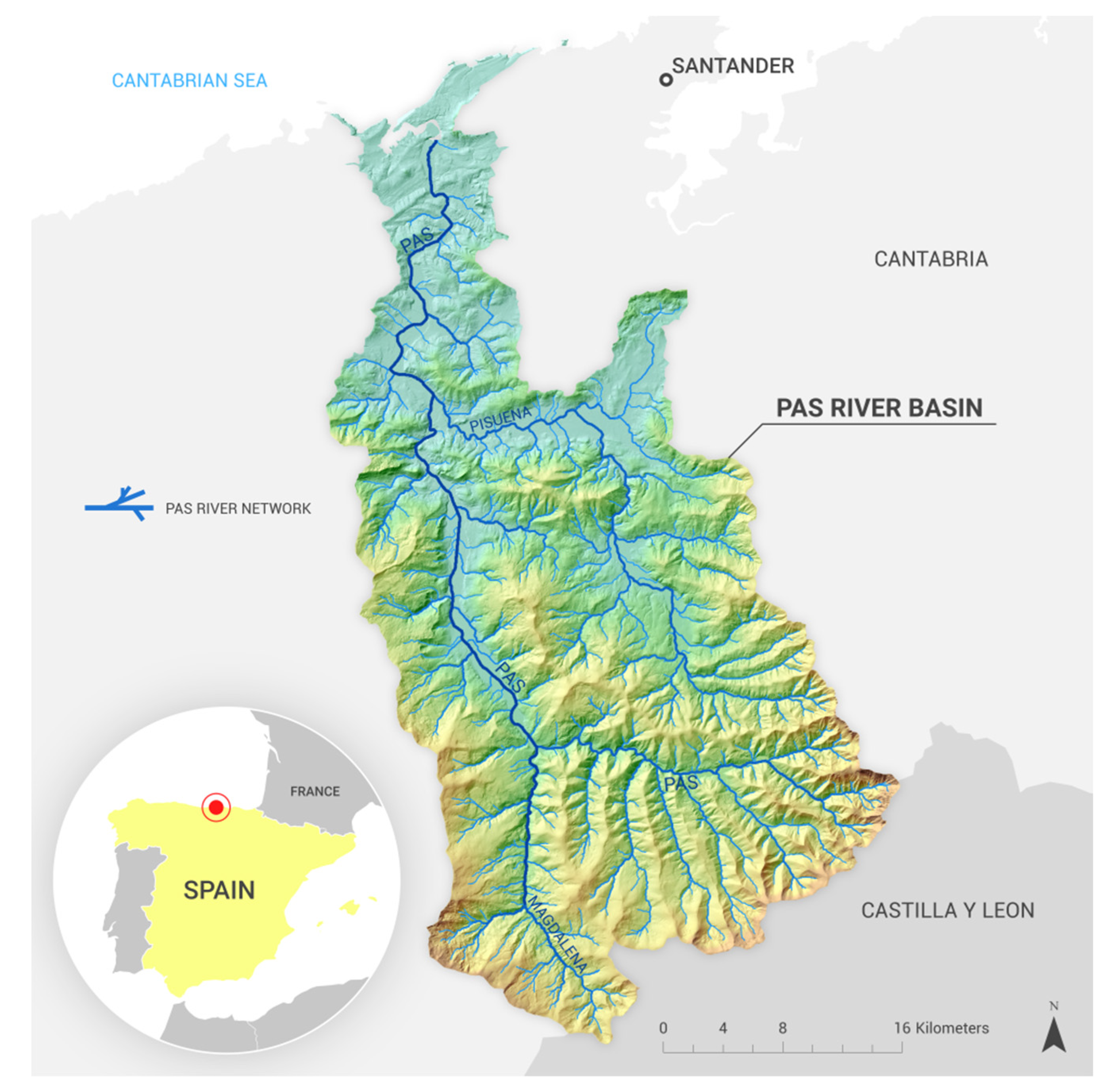

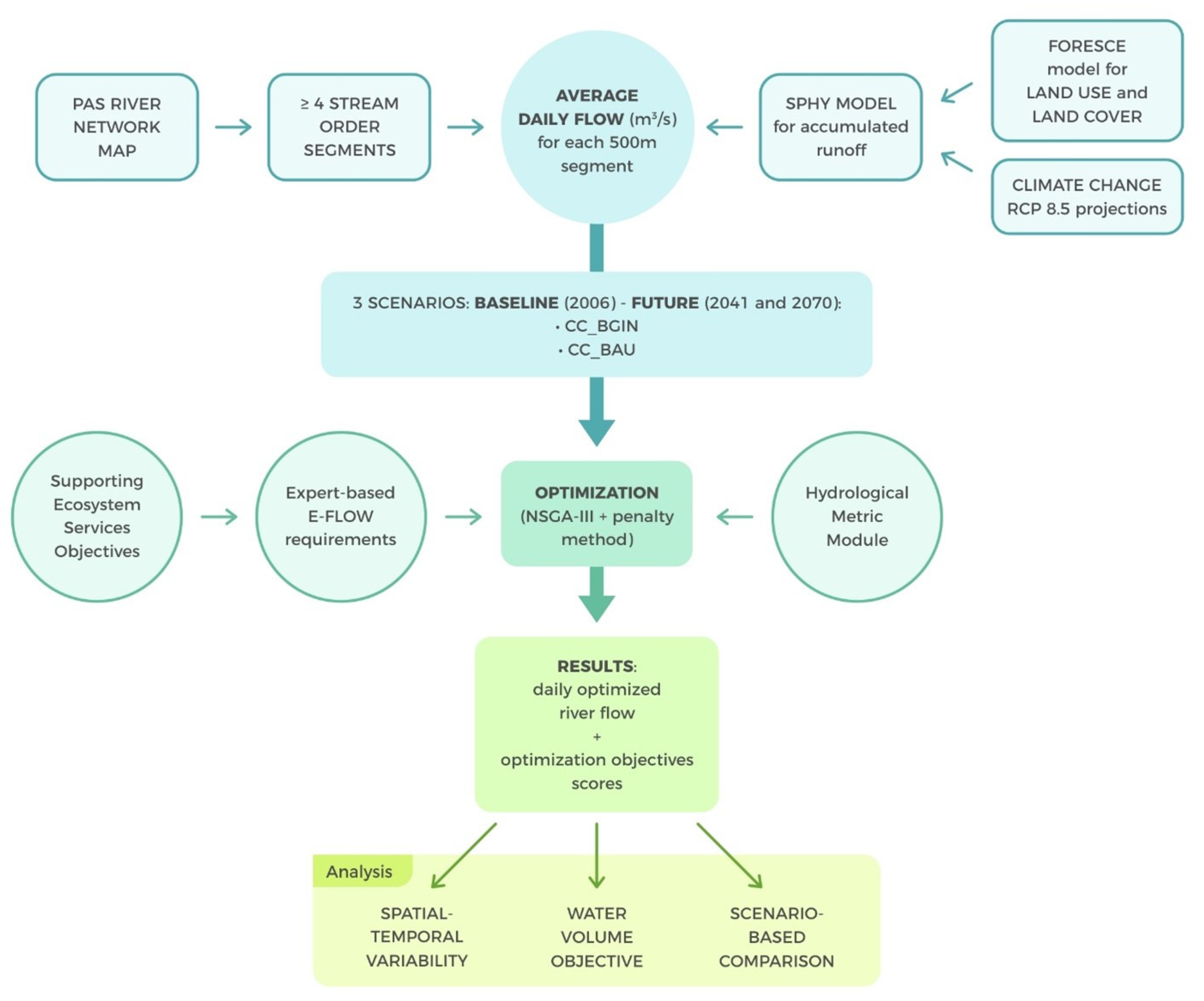
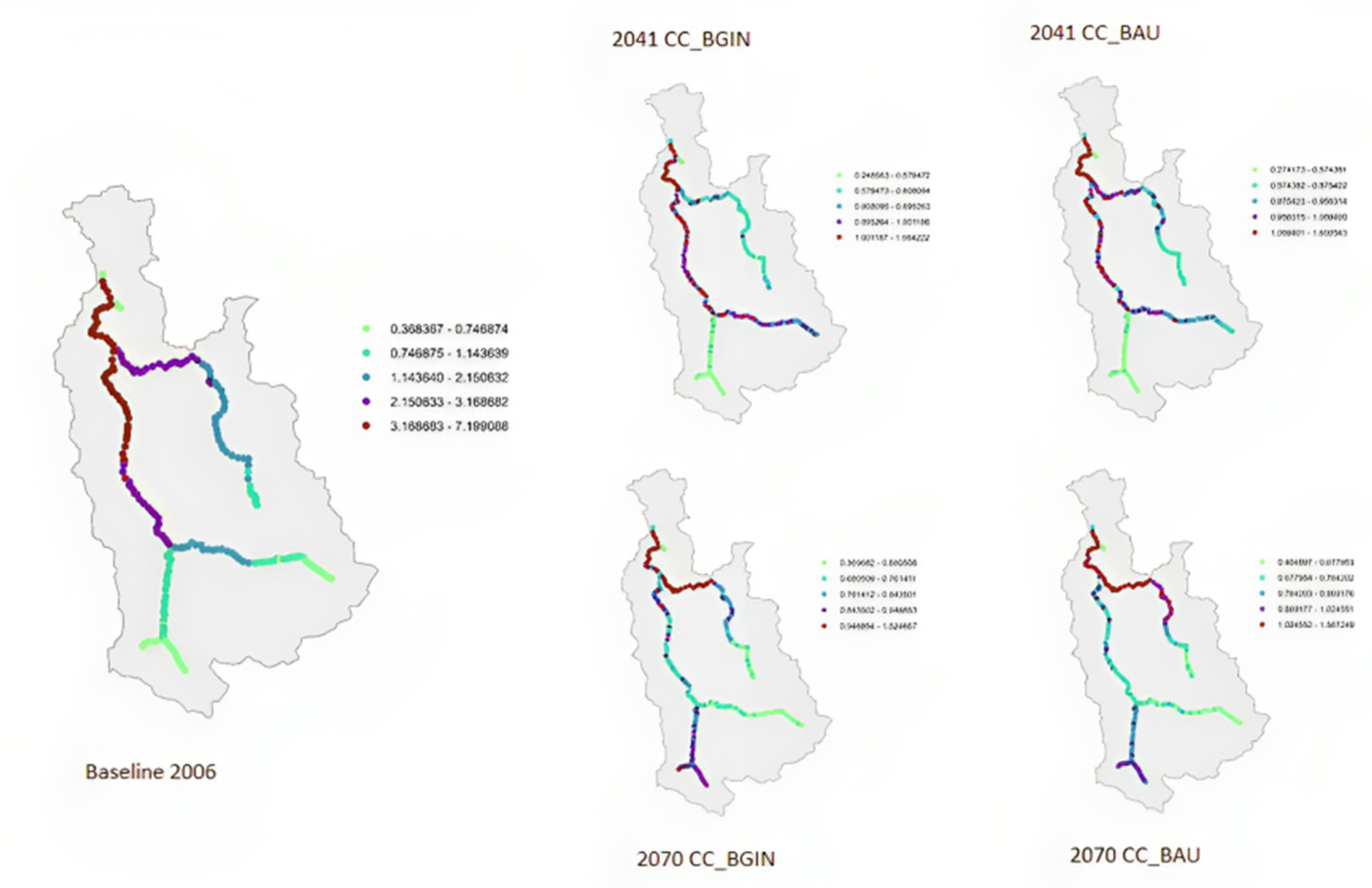

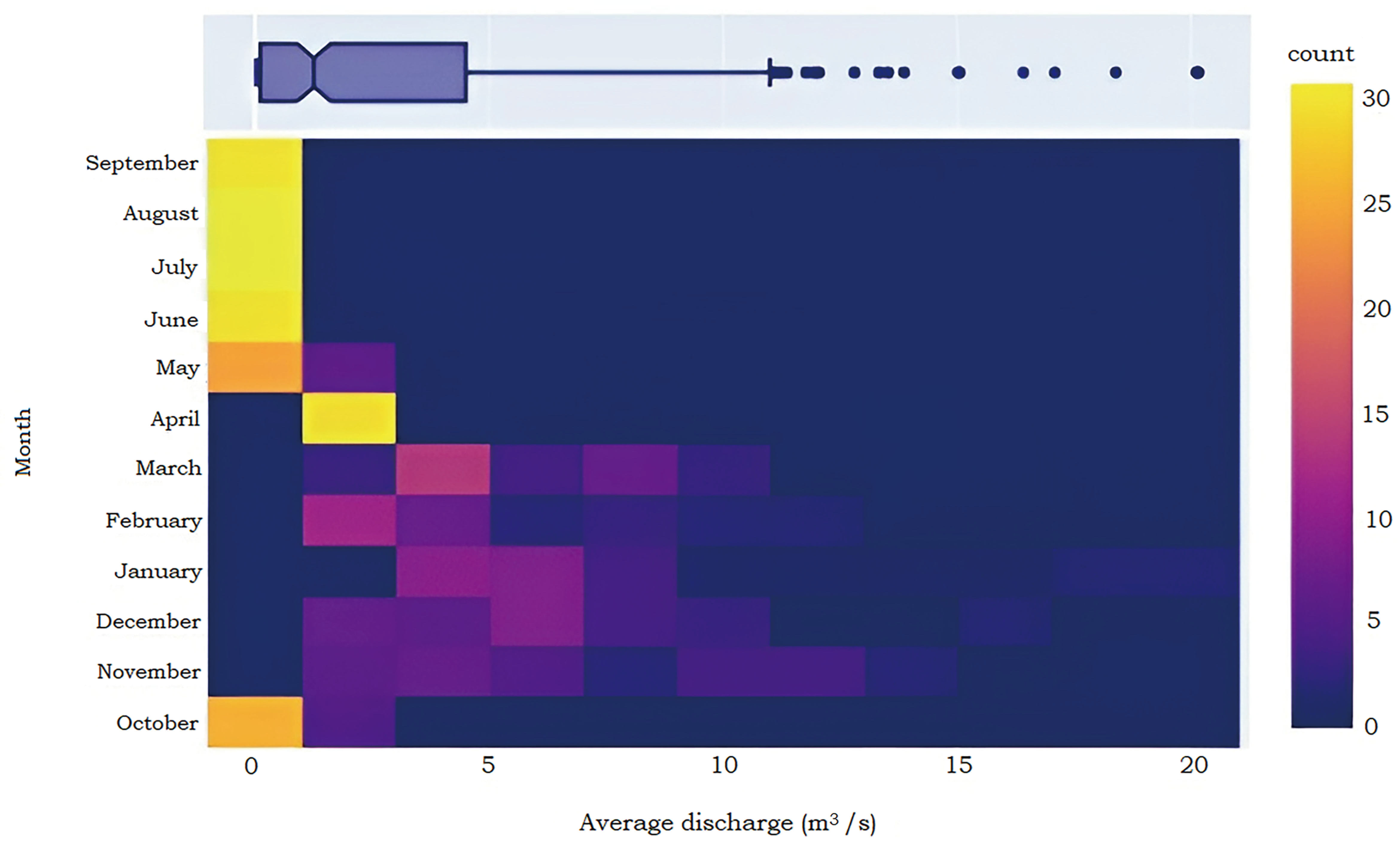
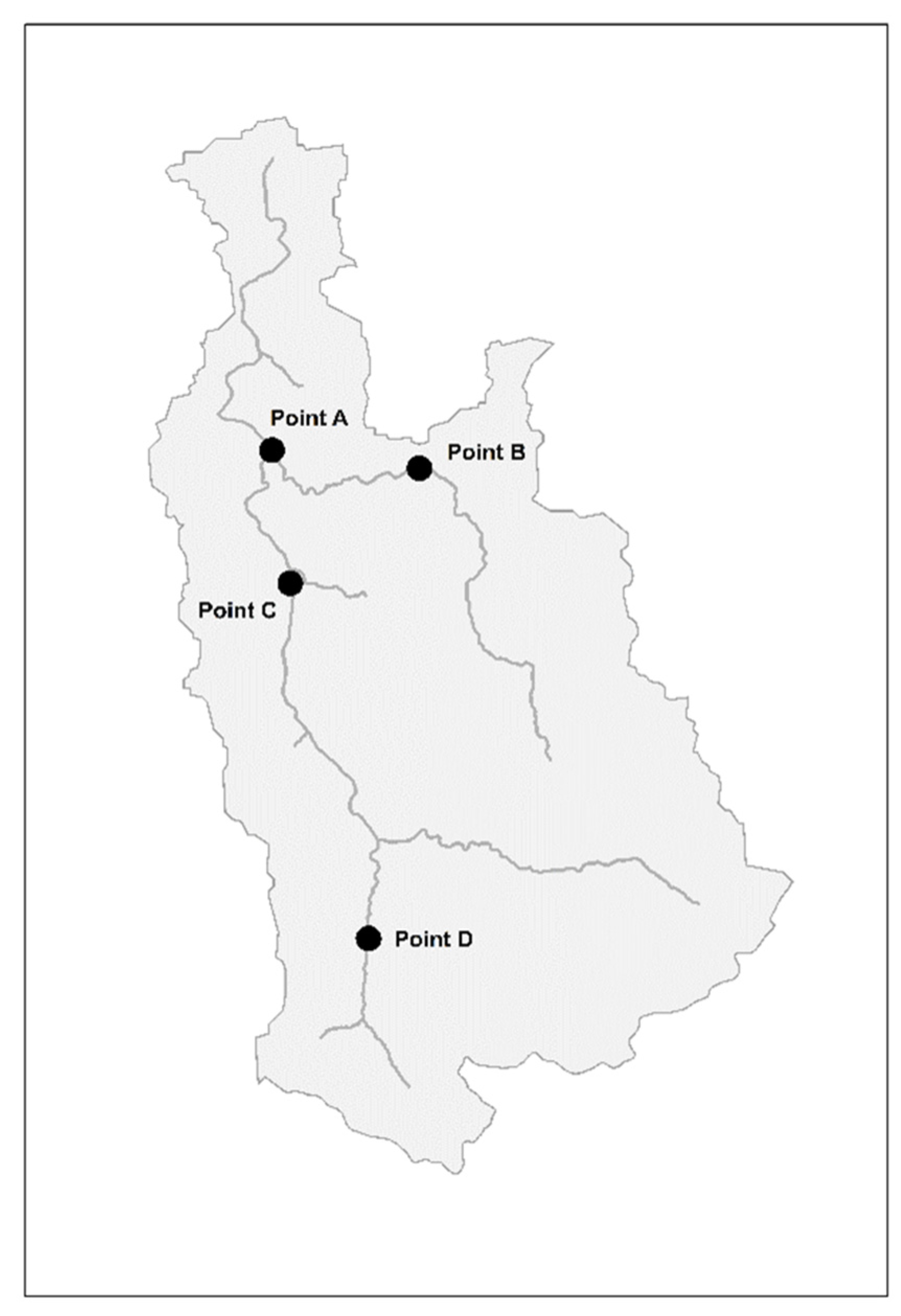
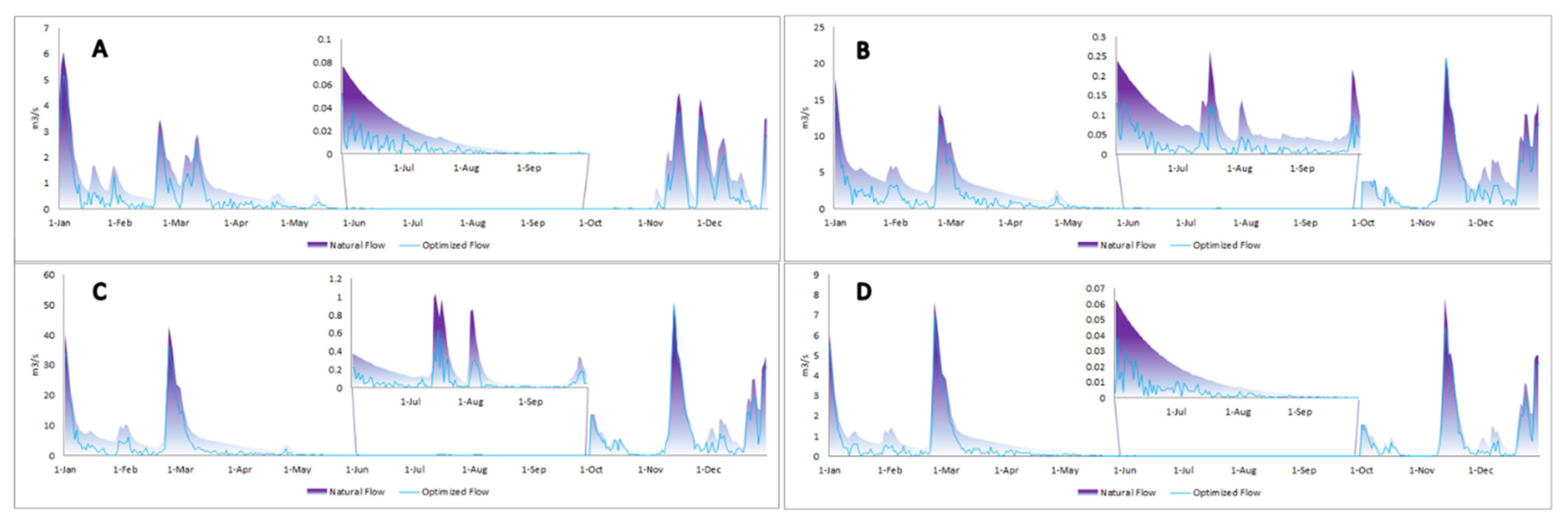
| Supporting Ecosystem Service | Indicator Description |
|---|---|
| Provision of habitat conditions for fish | Hydrological regimes linked with the maintenance of habitat conditions that support main life stages (i.e., migration, spawning, hatching, recruitment), especially during dry periods, and ensuring the occurrence of peak flows (e.g., for migration). |
| Life-supporting conditions for macroinvertebrates | Flow magnitude and variability conditions. Based on the occurrence of high flow events that promote the highest taxa occurrence probability (itself based on the Intermediate Disturbance Hypothesis; [52]. |
| Primary productivity | Hydrological conditions of minimum flow during dry periods fostering the maintenance of primary producers (i.e., establishment success and their ability to develop cover). |
| User | Issue | Description |
|---|---|---|
| Policy and Decision-makers in the frame of water management | Spatial domain | 1. Considering river segment-specific hydrological conditions when developing a diversion management plan can help identify areas of more stable discharge conditions for consumptive use. |
| Temporal domain | 2. Management planning should account for changes in diversion conditions throughout the year by retailoring objectives to seasonal scales. | |
| Future environmental conditions | 3. When planning diversion management, seasonal shifts due to climate and LULC change must be predicted, incorporated, and aligned with future management objectives. | |
| Ecosystem services | 4. Management planning should consider appropriate ES supply indicators and conditions based on the location of the river segment and the conservation objectives. | |
| Mixed | Forest indicators | 5. The effects of forest cover prioritization on available river water for diversion would be more evident if forest maturity rather than forest extent is prioritized. |
| Optimization modelers for water management/water management analysts | Importance of input data quality for optimization assessments | 6. Incorporate predictions of ecological adaptation to environmental changes for specific water management horizon. |
| Selection of the most appropriate scale | 7. Basin-scale modeling supports management scenario testing, while reach-scale modeling is more appropriate for constraint testing. | |
| Output type | 8. As large scales require extensive input data, setting clear objectives can help to process the volume of output data and clear communication of results. | |
| ES indicators | 9. Prioritize the hydrological requirements of some species downstream of the river network while focusing on others upstream, for example, by applying weights. |
Disclaimer/Publisher’s Note: The statements, opinions and data contained in all publications are solely those of the individual author(s) and contributor(s) and not of MDPI and/or the editor(s). MDPI and/or the editor(s) disclaim responsibility for any injury to people or property resulting from any ideas, methods, instructions or products referred to in the content. |
© 2023 by the authors. Licensee MDPI, Basel, Switzerland. This article is an open access article distributed under the terms and conditions of the Creative Commons Attribution (CC BY) license (https://creativecommons.org/licenses/by/4.0/).
Share and Cite
Derepasko, D.; Witing, F.; Peñas, F.J.; Barquín, J.; Volk, M. Towards Adaptive Water Management—Optimizing River Water Diversion at the Basin Scale under Future Environmental Conditions. Water 2023, 15, 3289. https://doi.org/10.3390/w15183289
Derepasko D, Witing F, Peñas FJ, Barquín J, Volk M. Towards Adaptive Water Management—Optimizing River Water Diversion at the Basin Scale under Future Environmental Conditions. Water. 2023; 15(18):3289. https://doi.org/10.3390/w15183289
Chicago/Turabian StyleDerepasko, Diana, Felix Witing, Francisco J. Peñas, José Barquín, and Martin Volk. 2023. "Towards Adaptive Water Management—Optimizing River Water Diversion at the Basin Scale under Future Environmental Conditions" Water 15, no. 18: 3289. https://doi.org/10.3390/w15183289
APA StyleDerepasko, D., Witing, F., Peñas, F. J., Barquín, J., & Volk, M. (2023). Towards Adaptive Water Management—Optimizing River Water Diversion at the Basin Scale under Future Environmental Conditions. Water, 15(18), 3289. https://doi.org/10.3390/w15183289







